The Amateur Mycologist #21 - The Nidulariaceae or Bird's Nest Fungi
These posts are not for foraging. They are intended for entertainment and intellectual satisfaction only. These posts are not a field guide nor comprehensive in any way - their accuracy is not assured in any way. Do not eat wild mushrooms unless you are a professional, have substantial professional assistance or have a wealth of personal experience with a specific species. Do not make any foraging decisions based on these posts. To do so could be dangerous or life threatening.
These Posts Contains No Information Regarding Edibility Or Toxicity
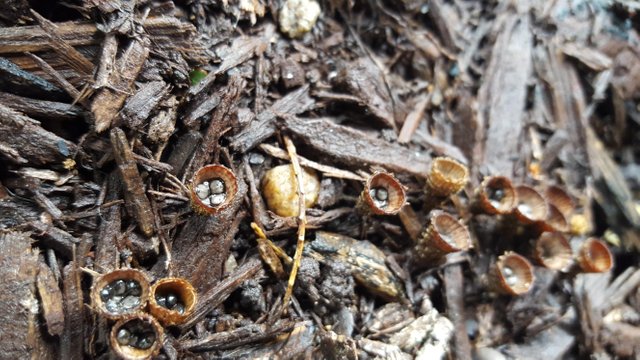
Today we discuss a whole new level of mycological weirdness
So far, most of the mushrooms we've encountered procreate using a roughly similar pattern. Usually, spores are released from a distinct pore surface on the underside of the mushroom. Some mushrooms, like the Stinkhorns change things up, replacing a pore surface with a spore slime that covers the icky head of the phallic shaped mushroom.
But even though the majority of mushrooms follow a conventional pattern of spore dispersal, there is no natural rule constraining mushrooms to adhere to the cap/pores structure.
Case in point, the Nidulariaceae family of mushrooms, a.k.a Bird's Nest fungi
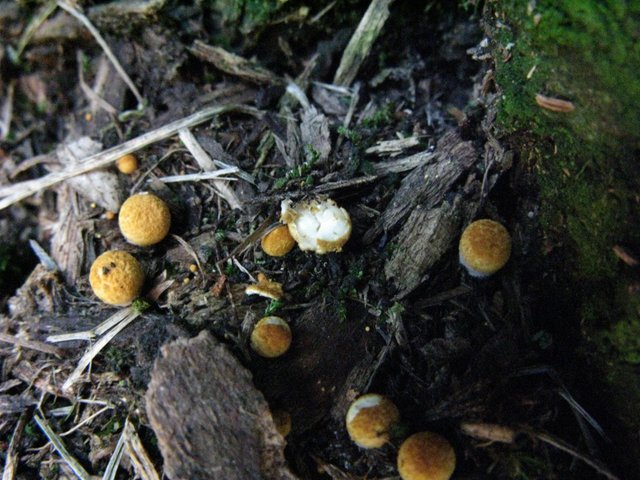
Bird's Nest fungi are tiny.
These images, both directly above and at the very top of this post, depict mushrooms no larger than 2mm across! The photo above is likely an immature specimen of a species called Crucibulum laeve - immature because I actually physically removed portions of the cap to expose the eggs inside.
The photo at the top above is a different species, possibly Cyathus striatus - compare the highly textured extrior portion of the nest and the clear groves inside of the nest, plus the darker eggs.
Both species operate on a totally different principle of spore dispersal than "normal" mushrooms
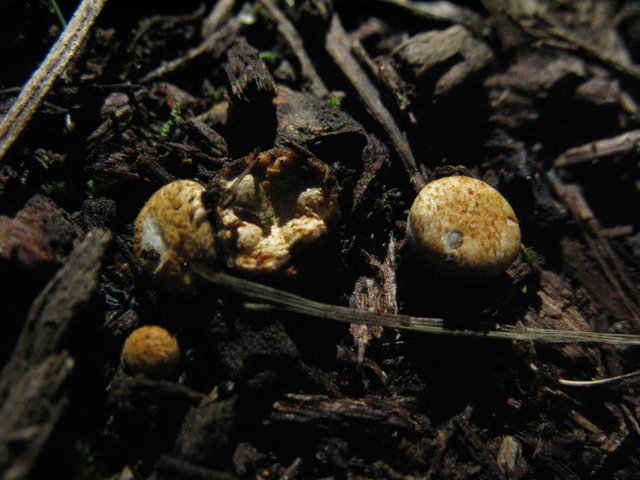
Let's focus on C.laeve for now
See the picture above? That is C.laeve in its immature form. The yellowish mushroom has not yet revealed the open nest and its eggs. Before this happens, the mushroom grows as an enclosed package. Then, as time passes and the spores become mature, the yellow top disappears entirely and the "eggs" are revealed.
These mushrooms were growing at the base of a deciduous tree in central park. However, they were almost certainly growing on a thin layer of dead organic material there, as opposed to working in conjunction with the tree. This is because these mushrooms are saprobic in nature.
Take a look again at the close up of the white, immature eggs.
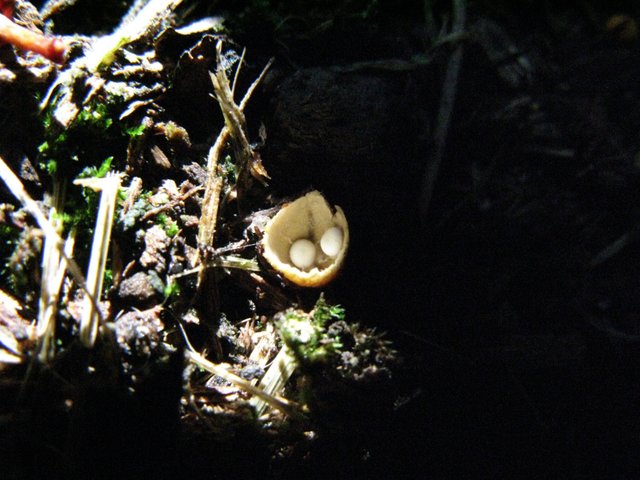
Try to zoom in on the image and you can see thin white strands inside the nest.
Some forms of bird's nest fungi connect the eggs to the nest with a thin strand, called a "funiculus," while others do not. C.laeve is one which does display this feature, although it is only luck that this photo caught sight of it.
This photo was achieved by scraping off the top of the mushroom by hand. But eventually that happens naturally as well.
Take a look at the hollow remnants of an older group.
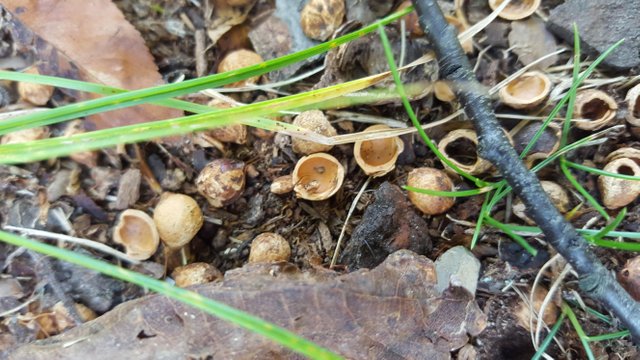
These C.laeve nests have served their purpose and are empty
The pressing question is what happened to the eggs? The answer is Raindrops!
Those inconspicuous droplets of water falling from the sky, usually just a nuisance to us, given our size, operate as high impact explosions for a colony of tiny C.laeve eggs.
What follows is an absurd act of gymnastics on a tiny scale. When a rain drop hits the nest, the eggs fly out of the nest and into the air. If the drop is large enough it propels the eggs at a fast enough speed that the cord rips. The place where cord rips is sticky and as the egg and the cord fly through the air, either the cord or the egg sticks to nearby detritus. If the cord sticks to something first, the egg swings back and sticks to it also, sort of like grapeshot.
This methodology may seem outlandish, but it works. The result is that you can find bird's nests all around the world. In the US you can find these kinds of mushrooms all over the place. I commonly find them at the base od deciduous trees - as I did with the two species highlighted here.
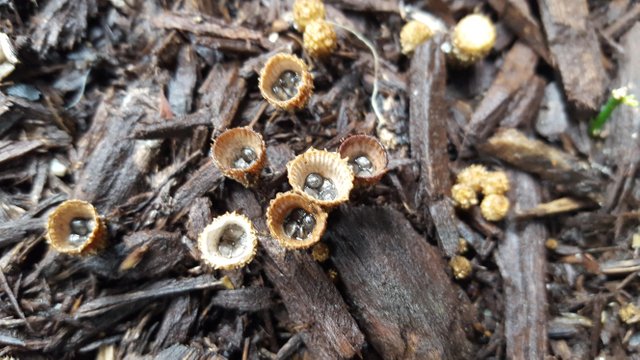
There are a fairly wide variety of bird's nest mushrooms.
Keep your eyes peeled - really get down low and look for small collections of round particulate - in the warmer months and you are quite likely to see some yourself.
Macroscopic Characteristics (Broadly Shared In Family)
Cap - might start with a small cap at first covering the eggs which then disappears. Other times the cap does not disappear but remains like a lid on the nest. Very tiny, ranging from several mm to undet a single mm
Pore Surface - no conventional pore surface, instead the spores are contained inside of the nest in the form of several "eggs". The eggs are sometimes connected to the nest via a cord called a funiculus, sometimes not. Both types disperse spores by being hit by raindrops.
Distribution - around the world with species all over the place.
Ecology - Saprobic, growing on dead organic material.
Other Traits - Egg colors and textures change by species, as does the exterior color and texture of the mushroom, as does the interior color and texture of the nest. All of these things are worth taking into consideration for a quality ID.
Photo Sources:
- My Own
Information Sources:
[1]Kuo on the family Nidulariaceae/Birds Nest
[2]Kuo on C.laeve
[3]Kuo on C.striatus
[4]Wikipedia on Nidulariaceae
[5]Tom Volk on C.striatus
I didn't know about the complex mechanism of Nidulariaceae to spread their spores. Really interesting.
I'm really surprised of the wide variety of mushrooms that you manage to find in Central Park.
Gary Lincolf has catalogued a veritable army of mushroom species with the NYMS living in central park and then another army living in Prospect Park. Despite being super tailored environments,they both have a strong mycological backbone.
I hope you will continue to share more such posts in the days to come!
I certainly plan to - no shortage of mushrooms thankfully
I saw something similar a couple of weeks ago. They growing in a cluster in some leaf litter at the base of a decaying tree.
I know there's not a lot of detali there, but does this look like something similar from what you can tell?
Those are quite pretty - but definitely not bird's nest fungi - they seem to have a more comventional stem/cap shape, but I assume on a smaller scale. Were they very tiny?
If so, one possibility is that they are some teensie species of mushroom, another is that they are an ill developed version of a larger sized mushroom.
Fascinating..and so so informative!
I'm glad you enjoyed it.
You seem like a fun guy lol, mushrooms are incredible animals, Im truly fascinated with them they come in so many verities and can do some amazing things. These looks really neat like a cup cake with something in it
There are some astonishing varieties for sure. Thanks for taking a look
@dber got you a $3.01 @minnowbooster upgoat, nice! (Image: pixabay.com)
Want a boost? Click here to read more!
What is this friend?I have never seen it?
Good post
That's really awesome read my article
https://steemit.com/health/@hemanth23/learning-effectively